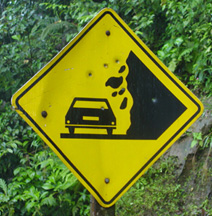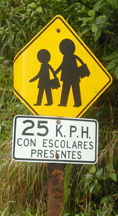 |
We always use Alamo. We pick up the rental at the Best Western Irazu in the Alamo office in the lobby. We have never had a negative experience with this agency. They also have satelite Alamo locations where you can swith out your vehicle if you are having a mechanical issue. |
| 011-506-2242-7733 |
http://www.alamocostarica.com |
|
|
|
|
|
|
|
| |
Advantages of Driving
Convenience
Outside of San José a private vehicle can be very convenient. In San José, you may find that parking and traffic jams make having a car more of a headache than it is worth.
Versatility & Flexibility
If the bed and breakfast you were planning on staying in misplaces your reservation, you can hop in your car and go few miles down the road, confident that in a short time you will run across another place to stay. If you are traveling by bus, then once you get to your destination you will probably be on foot, and a few miles down the road is a long way to walk.
Speed and Efficiency
When traffic is light and the roads are good, a car can be a quick way to get around, but don't think you are going to average 60 MPH. The roads are narrow, and many wind steeply through volcanic valleys. At times you will end up stuck behind a cattle truck going five miles an hour down the center line for an hour or more.
The rain is tough on the roads and construction and repair will also often delay you. On a few occasions, we passed long lines of cars on our bicycles, much to the frustration of the drivers.
Cost
A rental car costs a lot if you’re on your own, but for a group of three or four who want to visit a lot of locations it can compare favorably with the price of the bus. For example, an inexpensive four-passenger sedan can be had for $US 270 a week (including unlimited free mileage, taxes and mandatory Collision and Damage Waiver insurance). Don’t forget gasoline at around $US 3.00 a gallon.
Driving Tips
Slow down and be careful. You are in an unfamiliar environment, and the unexpected is the rule rather than the exception.
Driving at night is not recommended—It is dangerous because of the high percentage of other drivers who have been drinking, the inability to see potholes in the dark, precipitous drop-offs without guardrails, and because you will miss all of the scenery. Another danger entered the scene in 2004, car-jacking or robacarros and bajonazos who strike almost exclusively after dark.
Cones & Flares—The Tico version of orange cones and highway flares is a branch or pile of sticks in the road. Slow down, there is probably a dangerous situation ahead.
Do not leave anything of value in your car, ever—Not only is it likely that it will be stolen, but you may be responsible for the damage the thieves do getting it out.
Tickets—Modern traffic enforcement exists in Costa Rica and you can expect to face radar guns Some countries in Central America have well established cultures of “tipping” and bribery; Costa Rica is not one of them. There are no circumstances when it is appropriate to pay your “fine” on the roadside.
Stay off the area just above high tide line—Driving is allowed on some Costa Rican beaches, but please avoid the sand between the high tide mark and the trees because this is where the sea turtles make their nests.
Don't count on road signs for navigation—Although the situation is slowly improving there are very few.
How are the roads?
If you do any driving in Costa Rica, you will almost certainly do some traveling on the Pan-American Highway. This is the main artery of Costa Rican travel and is heavily used. The road is windy and somewhat dangerous driving in parts. However, the main highways are constantly improving in quality and in general are not unpleasant to drive. The roads to the more popular beaches are fairly well kept, but there are potholes that you would not expect in North America.
The biggest problem with driving in Costa Rica isn't the roads, it's the slow-moving vehicles (mostly trucks) that cause delays and the dangerous passes that frustrated drivers make in attempt to overtake them. You will probably have to make a few passes on double yellow lines if you rent a car and want to get anywhere fast, but use caution and drive VERY defensively. As there are few traffic cops in Costa Rica, drivers tend to be a little aggressive in their maneuvers. Roads to more remote locations (Osa Peninsula, Dominical, Monteverde) are in very poor shape and require a very sturdy 4x4. Driving times can vary greatly depending on traffic and road conditions. The drives to Jaco, Quepos, Playas del Coco and Puerto Viejo are, in our opinion, among the most pleasant and easiest to manage.
If renting a car in Costa Rica, make sure you've allowed yourself plenty of travel time between destinations. The mileage can be misleading when planning short trips, road signs are few and far between and driving at night is not a good idea. Also, please be advised of the risk of leaving
unattended luggage or valuables in your rental car. Consult the map on our site, which has driving distances between destinations. Bear in mind that you will probably average speeds of 70 to 80km per hour on highways and 40 to 50 on back roads:
What are the driving times between destinations?
It is very difficult to estimate accurate driving times as road conditions, traffic, time of day, and weather greatly affect how long it can take. These are very rough estimates. Typically one can average around 65-75 kilometers per hour on highways and 30-50 on side roads. Be careful to not allow yourself enough time between destinations. Driving in Costa Rica is much more fun if you are not in a hurry.
San Jose to Manuel Antonio: 3.75 hours
San Jose to Arenal: 4 hours
San Jose to Tamarindo: 5 hours
San Jose to Puerto Viejo: 3.75 hours
San Jose to Monteverde: 5 hours
San Jose to Jaco: 2 hours
San Jose to Golfito: 8 hours
City Driving in Costa Rica
It doesn't take long to realize that there is a different code of the road in Costa Rica (at least everyone who has survived to tell about it figured it out in a big hurry). The first clue will come when you notice the behavior of drivers at intersections. Check out a few cars at a few corners and you soon catch on that traffic signs carry one less level of authority here.
For example the octagonal red sign with "alto" printed on it translates as stop, and in some places that's what drivers do when they encounter one. In Costa Rica however this sign means slow down, proceed with caution, in other words the same thing that a yield sign means in the rest of the world. In a similar fashion a red traffic light means pause then proceed if there is an opening. Sounds suspiciously like a response to a stop sign in the rest of the world.
Oddly the government seems to conspire in this behavior; they have even invented a new traffic control that is used all over the country. It is a traffic light with a stop sign on the same pole. The combination of devices seems to carry a higher level of authority. When the light is red, and there is a stop sign present, drivers stop and wait for it to turn green before proceeding.
Parked cars are not necessarily a reliable clue to allowed directions of travel since you can be on a two-way street and still see all of the parked cars facing you. Parking is allowed on either side of the street.
Costa Rican Rental Car Insurance Explained (Sort Of)
Auto insurance in Costa Rica is a government monopoly of the INS (Instituto Nacional de Seguros). Liability insurance from the INS is mandated by law, but provides only minimal coverage. Rental agencies offer supplemental programs that cover deductibles and contingencies other than a simple traffic accident.
The cost of insurance can approach or exceed the cost of renting. These insurances may be replaced by your home auto insurance policy or credit card coverage. Check before you leave home, and get it in writing. Some credit card companies have exclusions specifically against Latin American rentals. More Confusion—The confusion and frustration involved in getting a fair price on a car rental gets worse before it gets better. Some rental car agencies lump the cost of one or more types of insurance into the rental cost, others combine the government insurance in their CDW or LDW coverage, and others seem to intentionally confuse the three types in order to make their rates appear better.Just get everything the first time you go so it can be off your mind. |









